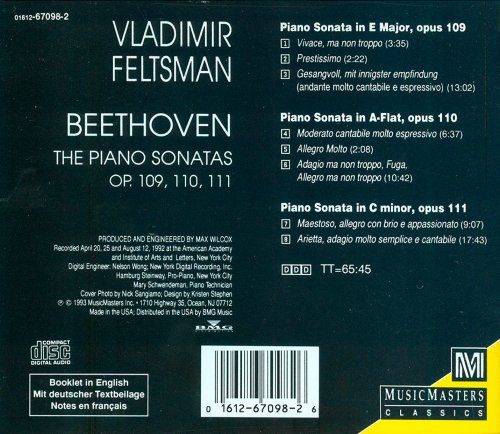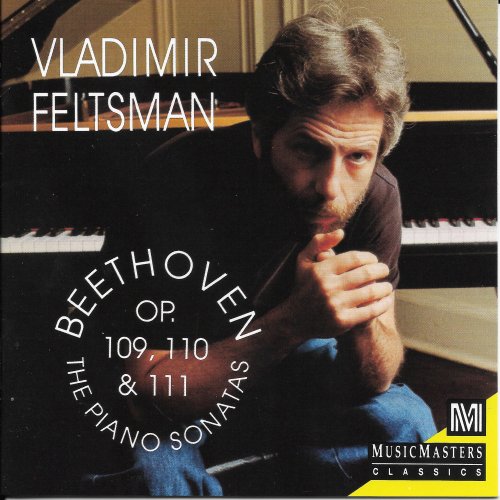
Vladimir Feltsman - Beethoven: Piano Sonatas Op. 109, 110 & 111 (1993)
BAND/ARTIST: Vladimir Feltsman
- Title: Beethoven: Piano Sonatas Op. 109, 110 & 111
- Year Of Release: 1993
- Label: Musical Heritage Society
- Genre: Classical Piano
- Quality: flac lossless (tracks)
- Total Time: 01:05:47
- Total Size: 179 mb
- WebSite: Album Preview
Tracklist
01. Piano Sonata No. 30 in E Major, Op. 109: I. Vivace, ma non troppo
02. Piano Sonata No. 30 in E Major, Op. 109: II. Prestissimo
03. Piano Sonata No. 30 in E Major, Op. 109: III. Gesangvoll, mit innigster Empfindung. Andante molto cantabile e espressivo
04. Piano Sonata No. 31 in A-Flat Major, Op. 110: I. Moderato cantabile molto espressivo
05. Piano Sonata No. 31 in A-Flat Major, Op. 110: II. Allegro molto
06. Piano Sonata No. 31 in A-Flat Major, Op. 110: III. Adagio ma non troppo. Arioso dolente. Fuga. Allegro ma non troppo
07. Piano Sonata No. 32 in C Minor, Op. 111: I. Maestoso-Allegro con brio ed appassionato
08. Piano Sonata No. 32 in C Minor, Op. 111: II. Arietta. Adagio molto semplice cantabile

‘From now on I intend to take a different road'. Beethoven's famous remark of 1802 could in a sense be thought of as his compositional adjuration throughout his life. But the appearance, from our vantage-point, is not of a different road but of many—crossing, diverging, reconnecting; a maze of crooked paths that Beethoven-asgenius could not resist exploring in all their extravagant detail. In particular he was torn between the vertical and the horizontal (chords/counterpoint), and between the dynamic and the contemplative. His increasing interest in counterpoint and the works of J.S. Bach meant that the sonatas of his 'last period' (say 1814-22) lose the configuration that distinguished the 18th century sonata from the fantasy or the prelude and fugue. The number of movements is variable, sometimes arguable and the balance between them often precariously held through dynamics, length, harmonic language and the chordal/contrapuntal flux.
01. Piano Sonata No. 30 in E Major, Op. 109: I. Vivace, ma non troppo
02. Piano Sonata No. 30 in E Major, Op. 109: II. Prestissimo
03. Piano Sonata No. 30 in E Major, Op. 109: III. Gesangvoll, mit innigster Empfindung. Andante molto cantabile e espressivo
04. Piano Sonata No. 31 in A-Flat Major, Op. 110: I. Moderato cantabile molto espressivo
05. Piano Sonata No. 31 in A-Flat Major, Op. 110: II. Allegro molto
06. Piano Sonata No. 31 in A-Flat Major, Op. 110: III. Adagio ma non troppo. Arioso dolente. Fuga. Allegro ma non troppo
07. Piano Sonata No. 32 in C Minor, Op. 111: I. Maestoso-Allegro con brio ed appassionato
08. Piano Sonata No. 32 in C Minor, Op. 111: II. Arietta. Adagio molto semplice cantabile

‘From now on I intend to take a different road'. Beethoven's famous remark of 1802 could in a sense be thought of as his compositional adjuration throughout his life. But the appearance, from our vantage-point, is not of a different road but of many—crossing, diverging, reconnecting; a maze of crooked paths that Beethoven-asgenius could not resist exploring in all their extravagant detail. In particular he was torn between the vertical and the horizontal (chords/counterpoint), and between the dynamic and the contemplative. His increasing interest in counterpoint and the works of J.S. Bach meant that the sonatas of his 'last period' (say 1814-22) lose the configuration that distinguished the 18th century sonata from the fantasy or the prelude and fugue. The number of movements is variable, sometimes arguable and the balance between them often precariously held through dynamics, length, harmonic language and the chordal/contrapuntal flux.
As a ISRA.CLOUD's PREMIUM member you will have the following benefits:
- Unlimited high speed downloads
- Download directly without waiting time
- Unlimited parallel downloads
- Support for download accelerators
- No advertising
- Resume broken downloads


